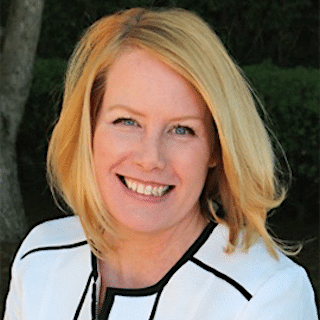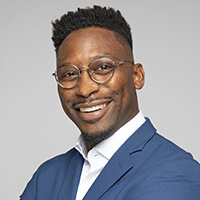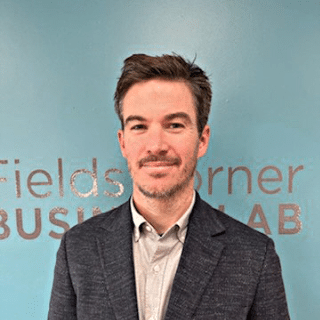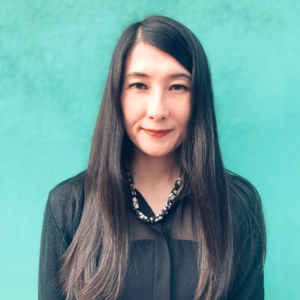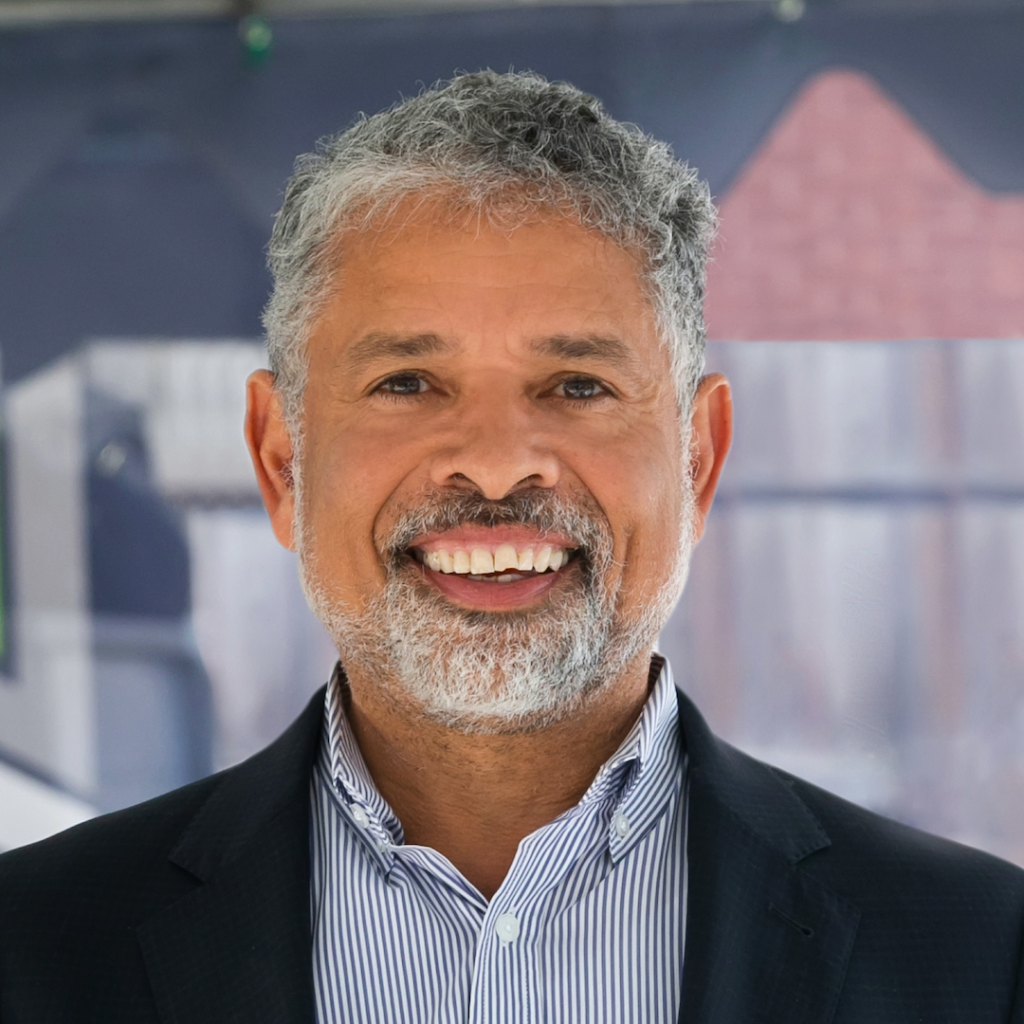
Adrian Washington says that until he was past 30, he had never even heard the term ‘real estate developer.’ Today he is known for over two decades of experience in urban real estate development, construction and management and the startup of several companies, the most notable being Neighborhood Development Company, founded in 1999 in his hometown of Washington, D.C. 100% minority owned, NDC is a triple-bottom-line company, responsible for over 1 million sf of completed residential and commercial projects, and about 1 million sf waiting in the development pipeline. Adrian also served for 18 months as the head of the Anacostia Waterfront Corporation, charged with leading the $10 billion, 20-year redevelopment initiative of the city’s Southwest and Anacostia Waterfronts.
Having started in management consulting, Adrian shifted gears after he bought an old brownstone in a run-down, but up and coming part of town. He started fixing it up, and found that he loved the process, as well the potential impact on the neighborhood, and eventually he found himself asking, why not try doing something you’re really passionate about? He has said, “I think disrupting is almost always good for an industry,” and true to that Adrian just launched a new business, Platform, to “revolutionize the way that buildings are built.” The idea is simple – integrate all the services required to build the platform (foundation structure) of a building to provide a ‘one stop shop’’ for this critical part of any construction project. Plus, they want to leverage ‘green technologies’ and are aiming to be carbon neutral in five years. It’s ambitious and challenging, but we wouldn’t expect any less.
Read the podcast transcript here
Eve Picker: [00:00:09] Hi there. Thanks for joining me on Rethink Real Estate. For Good. I’m Eve Picker and I’m on a mission to make real estate work for everyone. I love real estate. Real estate makes places good or bad, rich or poor, beautiful or not. In this show, I’m interviewing the disruptors, those creative thinkers and doers that are shrugging off the status quo, in order to build better for everyone. If you haven’t already, check out all of my podcasts at our website RethinkRealEstateForGood.co, or you can find them at your favorite podcast station. You’ll find lots worth listening to, I’m sure.
Eve: [00:01:05] Adrian Washington is determined. A veteran developer with a pedigree that includes a Harvard MBA, Adrian became a developer out of his love of cities. He founded the Neighborhood Development Company in Washington, D.C. over 20 years ago and has built 50 projects to date. Even early on, his goal was to provide affordable housing opportunities. His deals grew from four units to 100. And then the housing crisis hit. His biggest challenge was the rapidly rising construction costs, which make the job of building affordable extremely difficult. So, in 2021, he launched another company, Platform USA, which is focused on providing efficiency and affordability for the messiest, most inefficient part of constructing a building, the platform that supports the building above. This portion of a building amounts to 25% of a building’s cost but takes up 40% of the construction time. And Adrian’s company is on a path to create much more efficiency and therefore cost savings in this critical part of the structure. You’ll want to hear more.
Eve: [00:02:45] Hello, Adrian. Thanks so much for joining me today.
Adrian Washington: [00:02:48] Good morning, Eve. Thanks for having me.
Eve: [00:02:51] So you’ve been a real estate developer for decades, one of a pretty rare breed of Black developers. And I’m just wondering, what led you to become a real estate developer?
Adrian: [00:03:02] I became a real estate developer because I loved cities, I love housing, I love the interaction of all the energy that goes on in cities. And I wanted to provide opportunities for people to have affordable options to live.
Eve: [00:03:16] Okay. So that was the biggest problem to solve back then. And it sounds like it’s bubbled up to be one of the biggest right now. And then you went on to found your own company, Neighborhood Development Company, which you’ve owned for over 20 years now. Is that right?
Adrian: [00:03:32] That’s right. We were founded in the 1999 and exactly, as you said, Eve, that back then the challenge was sort of attracting people to cities. Cities still had a bad reputation, but I think we’ve become a victim of our own success. There are so many people flocking to cities and rents have gone up. Prices have gone up. So the challenge has become a totally different challenge than the one we started with.
Eve: [00:03:54] Yeah, actually, that’s a really good perspective. I remember when the word urban was a bad word, but it’s definitely not anymore, is it?
Adrian: [00:04:02] No, no. It’s quite a desirable place to live.
Eve: [00:04:05] Yeah, what a big shift. Okay, so tell us about the projects that you typically tackle. How big are they and what type of projects?
Adrian: [00:04:15] Okay. Well, we started with very small projects and as we’ve grown over the years, we’ve progressed to much bigger ones. So back in the beginning, our projects were very small buildings, four-unit buildings, six unit buildings, and we grew to now the typical building size that we do is somewhere plus or minus 100 units of housing.
Eve: [00:04:34] That’s pretty large and only housing or they mixed use, or commercial?
Adrian: [00:04:38] It’s primarily housing, but we have done several mixed-use buildings. We really focus, in terms of mixed-use of the commercial side, on neighborhood-serving commercial properties. So, for instance, we’ve done charter schools, we’ve done exercise studios, we’ve done fresh food markets, we’re doing a farmers market sort of marketplace in one of our current projects, we’ve brought medical care, health care. So housing is our main thing, but we’ve tried to provide retail and commercial options that help serve the neighborhoods we work in.
Eve: [00:05:13] And where do you find those?
Adrian: [00:05:16] We found this all over. I mean, primarily now because of the scale of projects we do, our projects are ground up. So typically, we will find vacant land in underserved parts of cities, and we’ll take those and we’ll develop what’s there. Sometimes we have to rezone them to make them more suitable. Sometimes we can just build on what’s called a ‘as is’ basis, but we find them in a variety of ways and a variety of places.
Eve: [00:05:40] And so over the years, like, how many buildings have you developed now?
Adrian: [00:05:44] We developed over 50 projects now.
Eve: [00:05:47] Oh, that’s pretty substantial. And you know, I forgot to ask you, where are they located? I know you live in D.C., but are all your projects there, or do you go further afield?
Adrian: [00:05:57] Primarily, most of our projects are in Washington, D.C. proper. We have a couple under development now in suburban Maryland and we’re expanding to suburban Virginia for future projects. So primarily this area. We looked at other areas of the country to expand. We have some, sort of, places that we’re interested in and I think in the years ahead we’re going to be there because we see the need, not just in the D.C. area, but in other areas as well.
Eve: [00:06:22] So what’s been the greatest challenge in doing this work over the years?
Adrian: [00:06:27] I think there’s been, I wish it was just one challenge, Eve. It’s really a number of challenges. I think that the big challenge we’re seeing now is the economics. Land prices have gone up somewhat, but really its construction costs have gone up tremendously. And the cost to build a building has gone up maybe three-fold since when I started. And also, the time it takes is increased as well. So, we’re constantly looking at ways to reduce that cost and reduce that time to build.
Eve: [00:06:59] And of course, that trickles down to the tenants, doesn’t it?
Adrian: [00:07:02] It absolutely does. I mean, the economics are hard to modify. If it costs you more to build, you’ve got to charge more rent in order to pay for the building.
Eve: [00:07:13] So the affordable housing crisis seems almost impossible to solve with all of this going on. It’s a little depressing, isn’t it?
Adrian: [00:07:20] Well, I mean, it’s not impossible. It’s challenging, you know, and we’re working on different ways. So, we’ve been able to overcome those challenges and we continue to try to get better in finding new ways to do that to meet the need. And we’re not going to be deterred. We’re going to make it happen.
Eve: [00:07:35] So that brings me to your new company which you just founded last year, I believe, called Platform USA. So what is Platform?
Adrian: [00:07:46] It’s called Platform because we’re really focused on the building platform, the part of the building that you really don’t see once the beautiful vertical part is built. But the platform is an extremely important part of the building. It’s where about 25% of the cost is, and it’s about really 40% of the time it takes to build a building is in that part of the building that’s scheduled there. So, we found that there were tons of money, tons of really smart people, lots of focus on the vertical part of the building but almost no company and no company that we’ve seen has a single-minded focus on the underground part of it. So that’s where we focus Platform.
Eve: [00:08:23] What are all the things that go into that underground part? You know, what sort of skills?
Adrian: [00:08:29] Yeah, there are five or six, primarily, components or trades that go into it. There’s the excavation actually digging the hole. There’s sheeting and shoring, holding up the hole before you pour the concrete in. There’s a concrete portion of it that’s part of the structure going up to what’s called a podium. But then there are things like underground utilities, there are things like testing, there’s environmental aspects. So, there are parts that are both what you typically consider the hard cost, construction and excavation, etc. But there are all these other types of things that are in the soft cost and what Platform does uniquely, it provides a one-stop shop for all of those things.
Eve: [00:09:09] And probably a lot of engineering, too, right?
Adrian: [00:09:12] Absolutely.
Eve: [00:09:13] And so how is that handled today and how are you hoping to shift that?
Adrian: [00:09:19] I mean, it’s a mess right now today. I mean, right now it’s just a forgotten backwater of the industry. And developers and contractors they have to go out and, you know, trade by trade, company by company, discipline by discipline, you know, handle all of those individually. So, you’d go out to a geotechnical company to do your drilling. You’d go to a structural engineer to design the underpinnings. You’d go to a excavation contractor to do that. And all of these entities have conflicting desires. There’s a lot of finger-pointing, it’s really a big mess. And so, I think our key innovation in platform is that you can go to one person, one company, a one-stop shop that can deliver all of that, and there’s no finger-pointing. You give us your specification for the platform, we give you a price, and we deliver on that price. One contract, one guarantee. This is much simpler, it’s much faster and it’s much cheaper.
Eve: [00:10:15] Interesting. So how are you going to build those capabilities?
Adrian: [00:10:20] We build them in a couple of ways. In the early phases, we’ve assembled a team of specialized one, who work with us project after project. We do that. So that’s phase one. But phase two, we’re going to acquire companies because we believe that the key to really getting the savings that we need to get is to have all those elements directly under our control. So, we’re going to do acquisitions, what’s sometimes called as a roll-up strategy to acquire these different companies. We have one company right now that we’re in discussions with and we’re going to add more as we go on. So, after year two, year three, we’ll have a fully integrated company with all these components under one roof.
Eve: [00:11:00] And what’s your progress so far?
Adrian: [00:11:02] So far, we’ve started construction on our first project. We are wrapping up our contract negotiations to start in the second. We have two more that we’re slated for later this year. So, we have very aggressive growth goals and right now we’re right on track for meeting this.
Eve: [00:11:20] Interesting. So, are the projects you’re going to focus on like the projects you build?
Adrian: [00:11:25] Well, that’s one of the great advantages Platform has. I mean, we have a sister company, my real estate development company Neighbohood Development Company and platform is going to be the exclusive platform provider for that. So, we’ve got a robust pipeline in Neighborhood Development Company. And so that provides a great underpinning, no pun intended, for Platform’s growth, but we’re also going out to third parties. So, we are negotiating several third party contracts right now, and we’re going to do both NDC’s projects and a much greater volume of third-party projects.
Eve: [00:11:57] Pretty fabulous. It’s a really interesting company. It’s got to cost a bit of money to buy these companies and scale up. And full disclosure, you’ve just started a crowdfunding offering on Small Change. So what’s your plan for the financials for this company? How do you think it will grow?
Adrian: [00:12:14] Clearly, the reason that we launched our crowdfunding campaign on Small Change is to provide equity for those acquisitions. I mean, the way our economics are set up, we’re going to be profitable very early on in terms of our base business where we’re predicting profitability for 2022. So, the equity need is not to fund the base operations of the company, but it’s to fund the acquisitions that we’re going to do. And so, we’ve built it into our budget. The money that we hope to raise on Small Change will fund the first couple of acquisitions. And then as we grow, we may go back to crowdfunding or we may use institutional equity to fund that acquisition growth.
Eve: [00:12:51] So what’s the ultimate goal here, Adrian?
Adrian: [00:12:53] The ultimate goal is to change the industry. I’ve been in the industry for decades, both on the development side as well as construction side, and there’s just like a crazy lack of innovation, particularly on underground components that Platform is going to address. So, our goal is nothing less than to change the industry, to change the way that platforms are created, to make the creation of platforms better, cheaper and faster. And by doing that, to lower the cost of housing to address that critical need in housing.
Eve: [00:13:25] Well, kudos, Adrian. It’s a really fascinating company and you’re tackling a super messy problem. So, I wish you great success.
Adrian: [00:13:35] Thank you.
Eve: [00:13:35] Can’t wait to see what happens.
Adrian: [00:13:37] Me too.
Eve: [00:14:00] You can find out more about this episode or others you might have missed on the show notes page at our website RethinkRealEstateForGood.co. There’s lots to listen to there. A special thanks to David Allardice for his excellent editing of this podcast and original music, and thanks to you for spending your time with me today. We’ll talk again soon, but for now, this is Eve Picker signing off to go make some change.
Images courtesy of Adrian Washington, Platform USA

